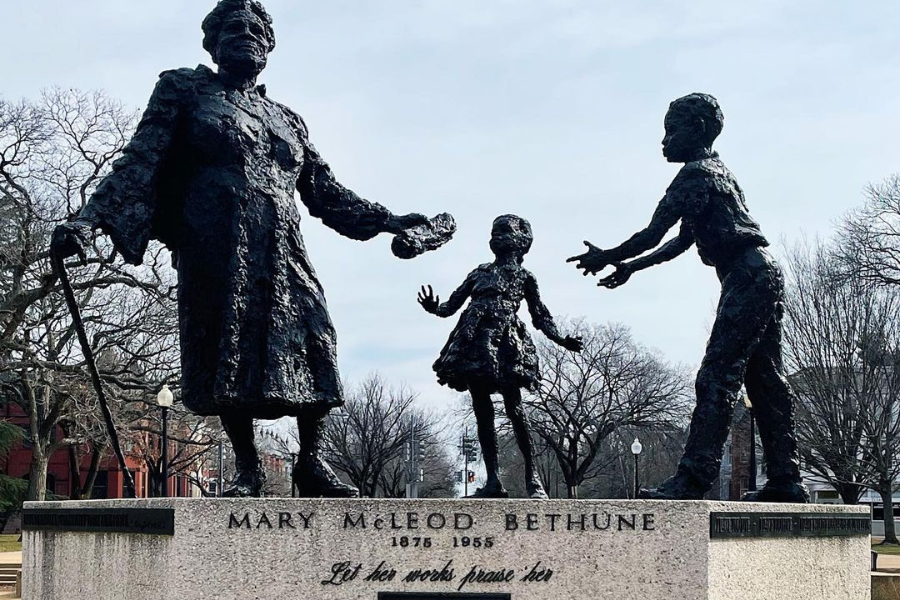From the city’s roots as a vibrant community for African Americans to the opening of the Smithsonian National Museum of African American History and Culture, Washington, DC is rich with African American history and culture. Check out the numerous ways to honor the vast and complicated history and fascinating culture of African Americans throughout the District.
01
Be amazed by the expansive Smithsonian National Museum of African American History and Culture

Through stunning architecture and four floors containing exhibits and thousands of artifacts, the newest Smithsonian museum details African American life, history and culture in incredible detail. This National Mall landmark is one of the city’s most popular attractions, so make sure to obtain your tickets to this free museum in advance.
02
Admire the Greensboro Lunch Counter

The Smithsonian National Museum of American History is home to the Greensboro Lunch Counter, one of the most important Civil Rights Movement artifacts. When four African American college students sat down at the counter in a North Carolina restaurant on Feb. 1, 1960, racial segregation was still legal in the U.S. By staying in their seats after being asked to leave, the students gave rise to a powerful movement that challenged inequality throughout the South.
03
Discover gems from the largest publicly held collection of African art in the U.S.

At the free-to-enter Smithsonian National Museum of African Art, you can enjoy a comprehensive look at the history of artistic expressions in Africa, allowing you to see the continent through a creative lens. The museum features a collection of roughly 12,000 artifacts, including stunning photographic archives and a world-class library.
04
Embrace Civil Rights history where Dr. King delivered his “I Have A Dream” speech

The National Mall has been the site of vital African American history, including the March on Washington led by Martin Luther King, Jr. in 1963 and the first Million Man March in 1995. You can also admire the spot where King delivered his “I Have A Dream” speech during the aforementioned March, as the spot can be found etched onto the Lincoln Memorial steps.
05
Stand beside Martin Luther King, Jr. at a majestic memorial

Situated on a four-acre, crescent-shaped site in West Potomac Park, the Martin Luther King, Jr. Memorial features a 30-foot statue of Dr. King carved into what is known as the Stone of Hope, which stands past two other pieces of granite known as the Mountain of Despair (both are references to his “I Have A Dream” speech). Visit the Inscription Wall to read incredible quotes from King’s speeches, sermons and writings.
06
Head east of the Anacostia River to the home of Frederick Douglass

Frederick Douglass National Historic Site
Famed abolitionist Frederick Douglass was born into slavery, but after running away, he became an outspoken advocate who had the ear of American leaders. During the Civil War, Douglass encouraged President Lincoln to live up to the ideals stated in the Declaration of Independence. Years later, Douglass bought his beloved home, Cedar Hill in Anacostia, and lived there until his death. The Frederick Douglass National Historic Site is currently closed to the public for renovations.
07
Honor the legacy of Mary McLeod Bethune

Mary McLeod Bethune was a prominent civil rights activist and organizer who stood up against racial and gender discrimination. The Mary McLeod Bethune Council House, situated near Logan Circle, is where the national political leader founded the National Council of Negro Women. Tours are offered on Thursdays and Fridays beginning at 9:45 a.m. and are given every thirty minutes (with the exception of 12-1 p.m.), with the last tour taking place at 4 p.m. Across town in Capitol Hill, you can also visit a statue dedicated in Mary McLeod Bethune’s honor.
08
Head to Benjamin Banneker Memorial Park in L’Enfant Plaza

Benjamin Banneker was a self-educated astronomer, farmer, mathematician and urban planner. In 1791, Banneker literally helped shape the District by working with Major Andrew Ellicott to survey the boundaries of the future nation’s capital. Benjamin Banneker Memorial Park, a favorite of landscape architects, pays homage to the surveyor.
09
Stroll through Shaw and pay homage to Duke Ellington

Walk through the historic Shaw neighborhood, once home to prominent African Americans, including jazz legend Duke Ellington, (whose statue resides in front of Howard Theatre). Ellington is one of the leading figures in jazz history and one of the primary musicians responsible for the city’s designation as “Black Broadway” in the early 20th century. The detailed statue sees Duke enveloped in piano keys and a musical note, a figurative yet accurate depiction of the lifelong musician. The Shaw neighborhood was named for Colonel Robert Gould Shaw, a member of the Massachusetts Volunteer Infantry of black soldiers who fought during the Civil War. The area earned the nickname, “The Heart of Chocolate City,” as escaped slaves settled there and eventually started businesses catering to the large population of African Americans. Once you are done admiring its history, check out Shaw’s awesome dining scene.
10
Visit U Street, once known as “Black Broadway”

If you want to learn even more about the local African American history in the nation’s capital, we urge you to read up on U Street, which was once known as “Black Broadway” and predates Harlem as one of the nation’s centers for African American art and culture. The neighborhood has also undergone an extensive revitalization over the last decade, making it one of the most vibrant sections of DC.
11
Visit the African American Civil War Memorial and Museum

Situated in the historic U Street neighborhood, the African American Civil War Memorial is dedicated to African American soldiers that served in the Union Army during the Civil War, making up more than 10 percent of the forces. The accompanying museum tells the story of these heroic troops.
Article originally posted here


